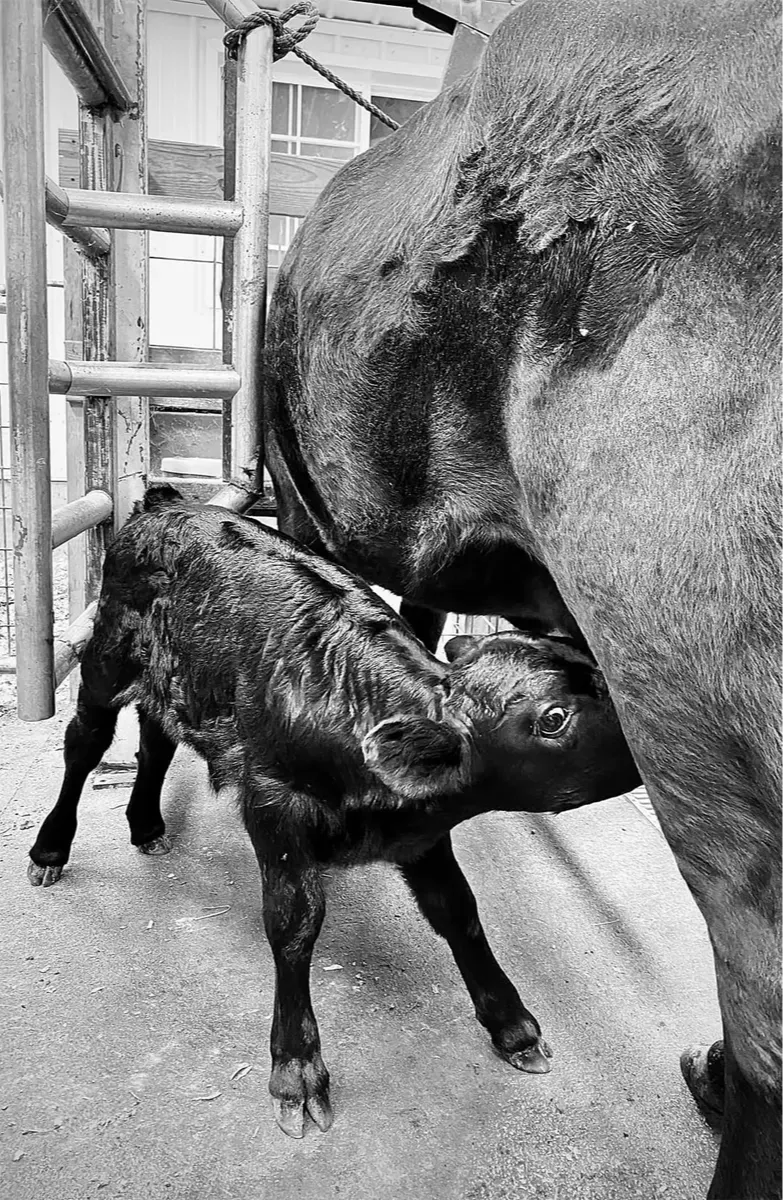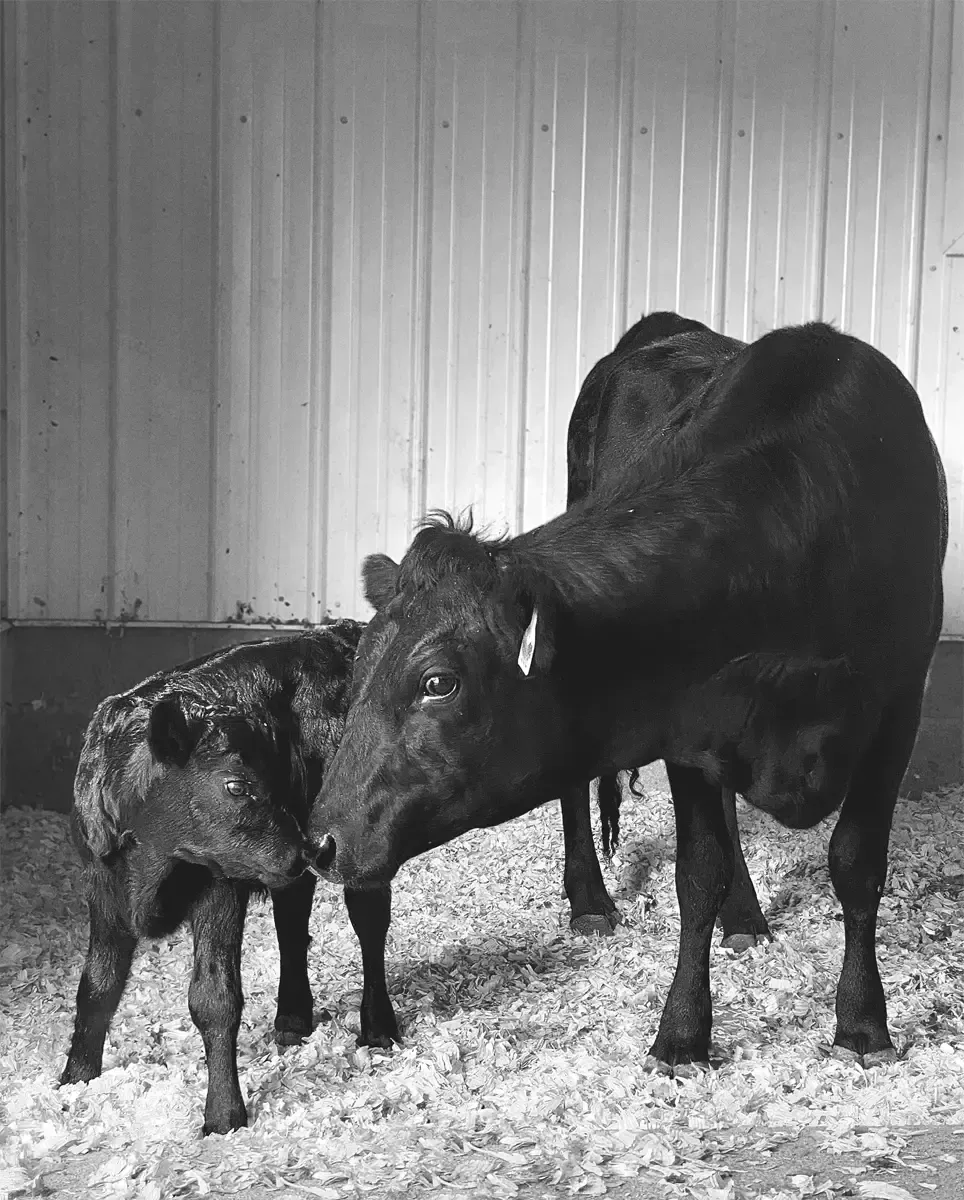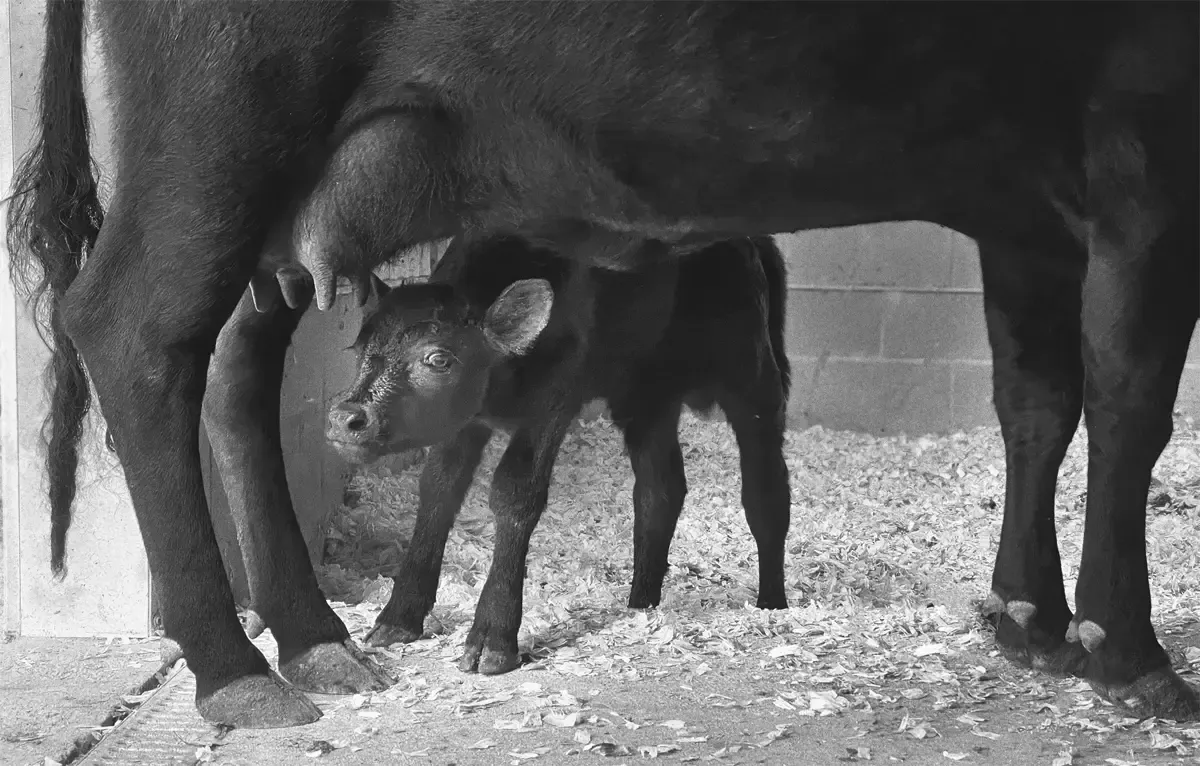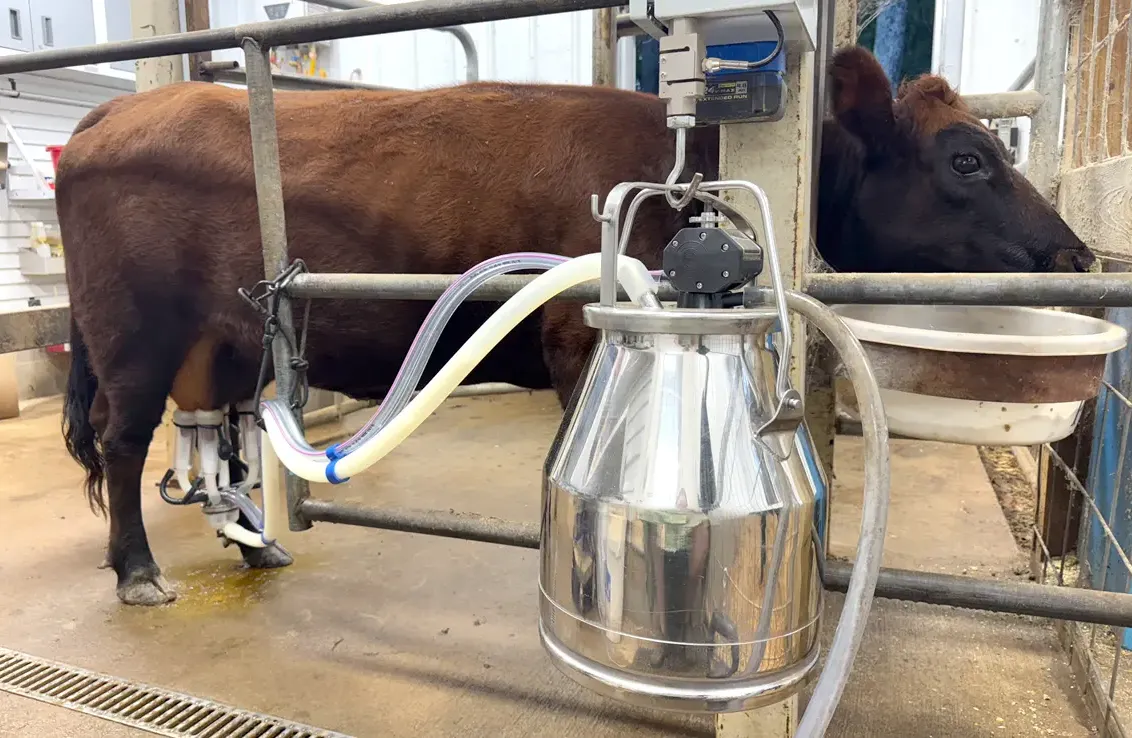Why I Don’t Calf Share with My Dexter Milk Cows
by Michelle Parsley, M.Photog., M.Artist, Cr.
The Calf-Sharing Dream — and the Hard Reality

I hear from families all the time who buy a Dexter hoping to calf share. The dream sounds simple: the calf nurses when you don’t need milk, and you step in when you do. It’s painted as the best of both worlds — no bottle-feeding, no separation guilt, and a little flexibility built into your milking schedule.
It sounds convenient. It sounds natural. It sounds like it should work.
But here’s the truth most folks don’t discover until they’re knee-deep in frustration — calf sharing almost never quite works the way people imagine it will. In fact, it’s one of the fastest ways to turn the peaceful rhythm of milking a family cow into a tug-of-war.
I understand why people want to try it. The idea of mama and baby staying together is beautiful. And yes, it can appear to work for a while — those first few weeks are often bliss. Some larger dairy breeds — like Jerseys — tend to tolerate calf sharing more easily, since generations of commercial selection have softened their mothering instincts. But Dexters aren’t Jerseys. They’re small, clever, fiercely devoted little cows, and in my experience, they don’t “share” well.
You want to be kind. You don’t want to feel like you’re taking anything away from the calf or the mother. But cows don’t understand sharing. To them, milk belongs to the baby — and once that bond is set, you’ll spend every milking session fighting nature itself.
Let’s talk about what calf sharing promises… and what really happens in the barn.
What Calf Sharing Promises
For many new milk cow owners, calf sharing sounds like the dream setup. The calf keeps the udder empty, the cow stays content, and you still get milk when you want it.
Less work.
It seems simple — let the calf handle most of the milking, and you can skip a day without worry. No strict routine, no rush to the barn, and no swollen udder to manage.
More flexibility.
Life happens. Kids get sick, weather turns bad, you want a weekend away — and calf sharing feels like built-in insurance. The idea that “the calf will take care of things” offers a kind of freedom that’s hard to resist.
A happy compromise.
It feels merciful — the calf stays with mom, and you still get your milk. Everyone wins, or at least it seems that way at first.
On paper, it looks like the perfect plan.
In practice, sometimes it works — and sometimes it quietly unravels.
📷 The picture of calm most families hope for — a content cow, healthy calves, and the promise of easy milking. Reality in the barn can be more complicated.

Related:
How to Train a Dexter HeiferThe Problems I’ve Seen Firsthand
I know some families make calf sharing work for a while — but in my barn, it hasn’t turned out well. Over the years, I’ve noticed the same handful of problems surface again and again, no matter how kind the intentions or careful the handling.
Inconsistent let-down.
Cows that hold milk for their calf often struggle to release fully for the milker. Once that habit sets in, it can be hard to undo. You can coax, massage, or strip all you want — but she’ll often keep saving the good stuff for her baby.
The cream disappears.
Calves tend to drink the richest milk, leaving what looks (and tastes) more like skim behind. Families counting on cream for butter or cheesemaking are sometimes surprised when there’s very little to be found.
Training troubles.
Heifers that aren’t milked without their calf from day one may have a harder time learning to let down for a human. They might fidget, step, or refuse until that calf is nearby or latched to a teat. Once that bond becomes part of their routine, it’s difficult — and sometimes stressful — to change. Even when the pattern can be corrected, it rarely happens without effort and patience from both cow and milker.
Milk cleanliness.
Even a healthy calf’s mouth can introduce bacteria that wouldn’t appear in a closed milking system. In my own, on-farm raw milk testing using RAWMI methods, I’ve seen bacterial counts shift dramatically when a calf is sharing the udder. What looks “natural” on the surface can quietly affect cleanliness and shelf life. That’s a risk I’m not willing to take with raw milk from my cows destined for other families.
Ruined reliability.
Once a Dexter starts saving milk for her baby, she may continue that habit even after the calf is weaned. Predictable yields often vanish — and with them, the easy rhythm between cow and milker that makes milking so rewarding.

My Dexter milkers are too smart. They’ll turn the spigots on for their calf and leave me without a drop, even when I'm milking at the same time the calf is nursing!
When Calf Sharing Fails Families
Over the years, I’ve heard from more than a few frustrated Dexter owners — families ready to sell their cows and switch to a different breed altogether. They loved their Dexters but couldn’t get enough milk to justify the feed costs. They were frustrated, and rightly so.
“She gives plenty for the calf, but without the calf, I can’t get a drop.”
That’s not a cow problem — it’s a training problem.
It’s not always what people want to hear, but it’s what I’ve seen proven time and again.
Once a Dexter learns to hold up milk for her calf, she’s simply following the pattern she’s been taught. No amount of coaxing, singing, massaging, or bumping the udder will change that overnight. The quick fix is to bring in the calf, let it latch until she lets down, then wrestle the calf away, re-clean the udder, and finish milking. It might work for a while, but as the calf grows, that “wrestling match” becomes a full-body workout — and even then, it’s rarely a sure thing.
I have more than one cow who can release milk for her calf and completely lock me out — even when the calf is nursing and I’m milking at the same time (which isn’t ideal from a sanitation standpoint — testing backs that up). As I’ve said before, Dexter mothers are clever, fiercely devoted little cows, and they don’t “share” easily. That’s not the sign of a bad cow; it’s the sign of an excellent mother who’s learned the wrong routine.
With time, patience, and retraining, success is absolutely possible — even with cows this devoted.
It’s always satisfying to hear those once-defeated words — “I’m selling my Dexters” — turn into, “She’s giving milk again!” All because we fixed the training.

The Supporters of Calf Sharing
I completely understand why some folks are passionate about calf sharing. For certain breeds, certain cows, and certain families, it can seem to work beautifully — at least for a while. I’ve talked with plenty of people who make it sound effortless.
Every now and then, though, I’ll hear someone strongly in support of calf sharing say, “I calf share because I can’t get milk unless the calf is there.”
That sentence always gives me pause because it reveals what’s really happening behind the scenes.
When a cow won’t let down without her calf, it’s not a sign of failure — it’s simply a sign that her training is incomplete. She’s learned to associate milk let-down with her baby, not her milker. That can happen easily, especially with intelligent, devoted breeds like Dexters.
With consistent handling and retraining, most cows do learn to let down reliably for their person. Good training builds trust. Consistency builds confidence. And over time, both cow and milker settle into a peaceful rhythm that doesn’t depend on whether the calf is nearby.
Some families prefer to keep the calf close and build their routines around that. Others, like me, find that full training and gentle separation create less stress long-term. Neither approach makes anyone wrong — it simply depends on your goals and what kind of relationship you want with your cow.
For my own barn, I want peaceful, predictable milking sessions twice a day with my ladies — without the headache of fighting a calf for what’s in the bucket. I like my body unbruised and my milking peaceful 🤣 (and in truth, I’ve rarely had kicks from any of my Dexters). My setup reflects that goal. The gates, stanchions, and pens I’ve built aren’t for outsmarting cows who hold up their milk; they’re for teaching heifers safely and setting a calm routine and high expectations from the start. Once a heifer understands her job, all that extra gear gathers dust. She walks in, stands quietly, and lets down cleanly — no calf, no gate, no drama.
That’s the difference between working against a cow’s nature and working with her instincts from the start.

Why Training Matters
Dexters are small, clever, and full of personality — and they thrive on consistency.
From the very first milking, my heifers learn that I take the milk, not the calf. Within a few days, they settle into the rhythm and stay that way for life. I’d much rather spend two days sorting out expectations than spend nine months of every year fighting a calf for every drop.
The result is calm, predictable cows that can be milked safely for 15–20 years — animals that trust their handler and find comfort in a familiar routine.
Curious how I raise my calves if I don’t calf share?
You can read about my bottle, nurse, and dam-raising systems in How I Raise My Dexter Calves
How I Raise My Dexter CalvesThe Heart of It All
For me, it all comes down to peace in the barn — calm cows, clean milk, and a love of the work that keeps me showing up twice a day, every day. Working with a cow’s instincts has helped me find the rhythm I was meant for: quiet mornings, steady milk, and a relationship built on trust.
In my barn, that means structure, training, and gentle separation. Every cow teaches me something new, but the framework stays the same: the milk cows know their jobs, the nurse cows know theirs, the calves grow strong, and the milk stays safe for the families who trust me to provide it.
These are the methods that have worked here — in my barn, with my cows, under my hands.
